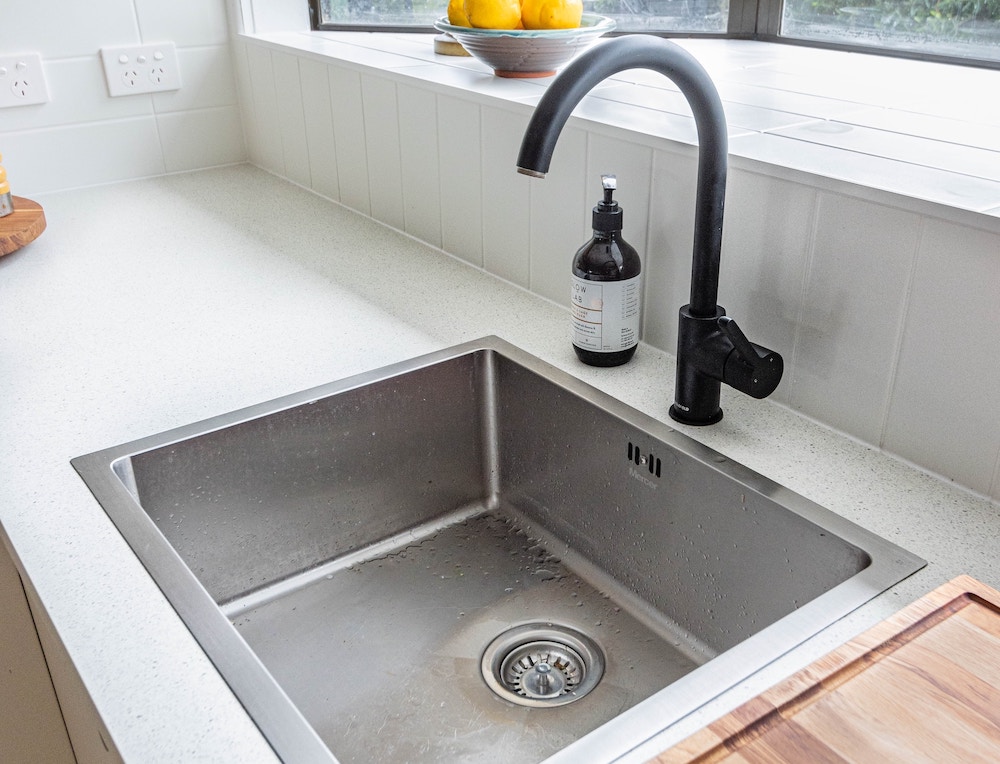What is a Waste Disposal Unit? A Complete Guide

What exactly are waste disposal units, and how do they fit into the broader context of sustainable living and kitchen innovation?
Join us as we delve deep into the mechanisms, merits, and considerations surrounding these under-the-sink appliances.
Whether you're a curious homeowner or an eco-enthusiast, it's time to uncover the story of waste disposal units in the UK.
Click here if you are interested in a kitchen sink waste disposal unit...
What is a Waste Disposal Unit?
A waste disposal unit is an electrically powered device installed under a kitchen sink.
Its primary purpose is to shred food scraps and waste into minute pieces, small enough to pass through plumbing without causing blockages.
Functioning at the simple flick of a switch, these units feature a grinding chamber where food waste is pulverised, with the assistance of sharp impellers and lacerating blades.
This mechanism ensures that the waste is finely ground, allowing it to be easily washed away by water from the sink.
It's a seamless process, blending effortlessly into the daily routines of kitchen users.
In the context of modern kitchens, the waste disposal unit offers a convenient solution for managing organic waste. Instead of placing food scraps directly into the bin, where they can decompose and produce odours, they're immediately processed and dispatched.
Though they have been utilised for several decades, the debate surrounding their environmental impact and efficiency continues.
However, what remains uncontested is the sheer convenience they introduce to the daily grind of kitchen activities, transforming the often tedious task of waste disposal into a swift and efficient process.
Click here to see our range of InSinkErator waste disposal units…
How Does a Waste Disposal Unit Work?
For many UK households, a waste disposal unit has become an indispensable kitchen appliance, streamlining the process of discarding food remnants.
But have you ever paused to consider the mechanism behind that hum and whirl, as it effortlessly grinds down your kitchen scraps?
- Activation: A waste disposal unit is typically situated beneath your kitchen sink, connected to the drain. To begin its operation, you'd usually run cold water from the tap, then switch on the unit. The water plays a crucial role, facilitating the movement of food particles through the plumbing system after they've been ground up.
- Grinding Chamber: Once activated, the food scraps inserted into the sink's drain enter the unit's grinding chamber. This chamber houses a shredding ring with sharp impellers, and it's where the magic happens.
- Pulverising Process: The waste disposal unit doesn't exactly have blades, as many assume. Instead, the impellers, aided by lugs mounted on the unit's interior, force food waste against the shredder ring. This continuous pulverising motion breaks down the food into minute particles.
- Elimination: As the waste is shredded, the running water combines with these tiny particles, forming a slurry. This mixture is then easily flushed through the unit's exit chamber and into the home's standard plumbing system. The fine consistency ensures that there's minimal risk of blockages in the pipes.
- Switch-off and Rinse: After the grinding is completed, the unit can be turned off, but it's recommended to let the water run for a few seconds more. This ensures that all food particles are flushed out, keeping the unit clean and preventing potential odours.
- Safety Features: Most modern waste disposal units come equipped with safety features. For instance, should a foreign object like a spoon accidentally fall into the unit, it would typically jam the mechanism, causing the unit to automatically shut off. This helps prevent damage to the appliance.
In essence, the waste disposal unit offers an efficient and hygienic method to handle kitchen scraps, eliminating the need for them to sit and decompose in your bin.
The entire process, from start to finish, is a testament to engineering ingenuity, providing households with a streamlined approach to waste management.
How to Use a Waste Disposal Unit
In many UK homes, waste disposal units have become a trusted ally in managing kitchen waste, offering a convenient and hygienic alternative to the traditional bin.
If you've recently installed one or are considering doing so, here's a step-by-step guide on how to use it efficiently and safely.
- Preparation: Before you start, ensure that the waste disposal unit is switched off. This is an essential safety measure to avoid accidental activation.
- Run Cold Water: Turn on the cold water tap to a moderate flow. Cold water helps to solidify any greasy residues, making them easier to grind and preventing them from sticking to the unit's components.
- Switch On the Unit: Once the cold water is running, turn on the waste disposal unit using the wall switch or built-in switch, depending on your model.
- Feed Waste Gradually: Begin by placing the food waste into the disposal, but do so gradually. Avoid cramming large quantities at once as this can overburden the system and cause jams.
- Suitable Waste Only: Remember, waste disposal units are designed primarily for organic, biodegradable waste. Avoid placing non-food items, hard bones, or fibrous materials like corn husks and onion skins. These can entangle the impellers and hinder the unit's operation.
- Let it Grind: Allow the unit to grind the waste completely. You'll typically hear a change in the grinding sound, from a vigorous crunch to a softer whir, indicating that the grinding is nearly finished.
- Switch Off the Unit: Once the grinding is complete, turn off the waste disposal unit.
- Run Water for a Few More Seconds: Continue to let the cold water flow for another 20-30 seconds. This ensures any remaining particles are flushed away, reducing the risk of blockages and ensuring the unit remains clean.
- Regular Cleaning: To maintain optimal performance and prevent odours, it's advisable to clean your unit periodically. You can do this by grinding small citrus fruit pieces, like lemon or orange, which also helps to deodorise the unit. Alternatively, use a mixture of vinegar and baking soda for a deeper clean.
- Safety First: Never insert your hand or any object into the waste disposal unit when it's operating. If you need to retrieve something or check the unit, always ensure it's switched off at the power source.
By following these steps and guidelines, you'll ensure that your waste disposal unit serves you efficiently for many years.
Remember, as with any appliance, regular maintenance and sensible usage are key to longevity and optimal performance.
Why Have a Waste Disposal Unit?
In many British households, the traditional method of managing kitchen waste has been through the trusty bin and recycling system.
However, the emergence and growing popularity of waste disposal units have many wondering:
Why opt for this device?
- Convenience and Efficiency: Forget the daily trudge to the outdoor bin with your food scraps. With a waste disposal unit, you can quickly dispose of kitchen waste right at the sink, streamlining the process and reducing the need for frequent bin emptying.
- Odour Reduction: Decomposing food waste in bins can lead to unpleasant odours, especially during warmer months. By grinding and flushing away this waste, disposal units help in maintaining a fresher-smelling kitchen.
- Hygiene Enhancement: Minimising the amount of decomposing food in your kitchen bin reduces the attraction for pests such as flies, ants, and even rodents. This leads to a more hygienic kitchen environment.
- Less Landfill Waste: Directly disposing of organic waste can lead to a reduction in the volume of household rubbish going to landfills. In landfills, organic waste decomposes anaerobically, leading to the production of methane – a potent greenhouse gas.
- Support for Local Wastewater Treatment: While there are concerns about the additional load on wastewater treatment facilities, many modern plants can convert organic materials into biogas, which can then be used as an energy source.
- Potential Plumbing Benefits: A well-maintained waste disposal unit can reduce the chances of sink blockages, as it grinds down food particles, ensuring they don’t coalesce and block drains.
- Space-saving: With many UK homes limited for space, especially in urban areas, a waste disposal unit offers a compact solution to waste management, freeing up space in your kitchen and reducing the need for larger or multiple bins.
- Modernising the Kitchen: A contemporary kitchen equipped with modern appliances, including a waste disposal unit, can enhance property appeal, especially if you're considering selling or letting in the near future.
- Economic Benefits: Over time, using a waste disposal unit may lead to savings. With reduced rubbish bags, fewer bin cleanings, and potential savings on waste collection services, the unit can be cost-effective in the long run.
- Eco-conscious Living: As environmental concerns become more pronounced, adopting tools and practices that support sustainable living becomes crucial. A waste disposal unit, when used responsibly, aligns with this ethos, promoting efficient waste management and reduced environmental impact.
So, the addition of a waste disposal unit in UK homes presents numerous benefits, from enhancing kitchen hygiene to promoting environmentally-friendly waste management practices.
As with all appliances, it's essential to use and maintain them correctly to maximise their advantages.
Some Notes From an Expert Kitchen Fitter
From years as a kitchen fitter, I've seen the transformative power of waste disposal units.
Their integration simplifies kitchen waste management remarkably.
Gone are the days of foul-smelling bins; these units grind and flush away food scraps, reducing odours and deterring pests.
Also, they can aid in preventing drain blockages by breaking down food particles efficiently.
Modern units are also surprisingly quiet and space-efficient, fitting seamlessly into contemporary kitchen designs.
For homeowners prioritising convenience and hygiene, waste disposal units have become an indispensable kitchen companion.
Final Notes On Waste Disposal Units
As we draw this comprehensive guide to a close, it's evident that waste disposal units have revolutionised the way we manage kitchen waste in the UK.
Their blend of convenience, hygiene, and environmental benefits positions them as more than just a kitchen accessory – they're a testament to innovative solutions that make our daily lives easier and more sustainable.
While they may not be a fit for every household, for those who adopt them, the benefits are palpable.
Like any kitchen appliance, they require care, understanding, and responsible usage.
But, when used effectively, they promise a cleaner, fresher, and more efficient kitchen environment.
Whether you're on the fence about installing one or merely wanted to understand their workings, we hope this guide has shed light on the marvel that is the waste disposal unit.

